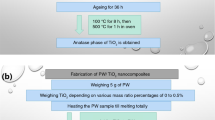Abstract
The aim of this study is to investigate the melting/freezing characteristics of paraffin by adding Cu nanoparticles. Cu/paraffin composite phase change materials (PCMs) were prepared by a two-step method. The effects of Cu nanoparticles on the thermal conductivity and the phase change heat transfer of PCMs were investigated by the Hot Disk thermal constants analyzer and infrared monitoring methods, respectively. The maximum thermal conductivity enhancements up to 14.2% in solid state and 18.1% in liquid state are observed at the 2 wt% Cu/paraffin. The photographs of infrared monitoring suggest that the melting and freezing rates of Cu/paraffin are enhanced. For 1 wt% Cu/paraffin, the melting and freezing times can be saved by about 33.3 and 31.6%, respectively. The results provide that adding nanoparticles is an efficient way to enhance the phase change heat transfer of PCMs.




Similar content being viewed by others
References
Patrice P, Cynthia AC, Ian BM, Adam W. A review of available methods for seasonal storage of solar thermal energy in residential applications. Renew Sust Energ Rev. 2011;15(7):3341–59.
Nithyanandam K, Pitchumani R. Analysis and optimization of a latent thermal energy storage system with embedded heat pipes. Int J Heat Mass Tranf. 2011;54(21–22):4596–610.
Kousksou T, Jamil A, Rhafiki TE, Zeraouli Y. Paraffin wax mixtures as phase change materials. Sol Energy Mat Sol C. 2010;94(12):2158–65.
Zhong YJ, Li SZ, Wei XH, Gao XQ, Shi JL, Guo QG, Liu L. Carbon matrices with different pore structures as heat transfer intensifier in paraffin wax/carbon thermal energy storage system. Carbon. 2010;48(5):1695–795.
Xiang J, Drzal LT. Investigation of exfoliated graphite nanoplatelets (xGnP) in improving thermal conductivity of paraffin wax-based phase change material. Sol Energy Mat Sol C. 2011;95(7):1811–8.
Agyenim F, Hewitt N, Eames P, Smyth M. A review of materials, heat transfer and phase change problem formulation for latent heat thermal energy storage systems (LHTESS). Renew Sust Energ Rev. 2010;14(2):615–28.
Ermis K, Erek A, Dincer I. Heat transfer analysis of phase change process in a finned-tube thermal energy storage system using artificial neural network. Int J Heat Mass Tran. 2007;50(15–16):3163–75.
Wang N, Zhang XR, Zhu DS, Gao JW. The investigation of thermal conductivity and energy storage properties of graphite/paraffin composites. J Therm Anal Calorim. 2011. doi:10.1007/s10973-011-1467-z.
Mettawee EBS, Assassa GMR. Thermal conductivity enhancement in a latent heat storage system. Sol Energy. 2007;81:839–45.
Gao JW, Zheng RT, Ohtani H, Zhu DS, Chen G. Experimental investigation of heat conduction mechanisms in nanofluids. Clue on clustering. Nano Lett. 2009;9(12):4128–32.
Zeng JL, Sun LX, Xu F, Tan ZC, Zhang ZH, Zhang J, Zhang T. Study of a PCM based energy storage system containing Ag nanoparticles. J Therm Anal Calorim. 2007;87(2):369–73.
Zeng JL, Cao Z, Yang DW, Sun LX, Zhang L. Thermal conductivity enhancement of Ag nanowires on an organic phase change material. J Therm Anal Calorim. 2010;101(1):385–9.
Zeng JL, Cao Z, Yang DW, Xu F, Sun LX, Zhang XF, Zhang L. Effects of MWNTs on phase change enthalpy and thermal conductivity of a solid-liquid organic PCM. J Therm Anal Calorim. 2009;95(2):507–12.
Ho CJ, Gao JY. Preparation and thermophysical properties of nanoparticle-in-paraffin emulsion as phase change material. Int Commun Heat Mass. 2009;36(5):467–70.
Hong Y, Ding SJ, Wu W, Hu JJ, Voevodin AA, Gschwender L, Snyder E, Chow L, Su M. Enhancing heat capacity of colloidal suspension using nanoscale encapsulated phase-change materials for heat transfer. Acs Appl Mat Interfaces. 2010;2(6):1685–91.
Wang JF, Xie HQ, Xin Z. Thermal properties of paraffin based composites containing multi-walled carbon nanotubes. Thermochim Acta. 2009;488(1–2):39–42.
Fan L. Enhanced thermal conductivity and expedited freezing of nanoparticle suspensions utilized as novel phase change materials. Alabama: Auburn University; 2011.
Cui Y, Liu CH, Yu X. The experimental exploration of carbon nanofiber and carbon nanotube additives on thermal behavior of phase change materials. Sol Energy Mat Sol C. 2011;95(4):1208–12.
Liu YD, Zhou YG, Tong MW, Zhou XS. Experimental study of thermal conductivity and phase change performance of nanofluids PCMs. Microfluid Nanofluid. 2009;7(4):579–84.
Khodadadi JM, Hosseinizadeh SF. Nanoparticle-enhanced phase change materials (NEPCM) with great potential for improved thermal energy storage. Int Commun Heat Mass. 2007;34(5):534–43.
Guo CX. Application study of nanoparticle-enhanced phase change material in ceiling board. Adv Mater Res. 2011;150:723–6.
Wu SY, Zhu DS, Zhang XR, Huang J. Preparation and melting/freezing characteristics of Cu/paraffin nanofluid as phase-change material (PCM). Energ Fuel. 2010;24:1894–8.
Wu SY, Zhu DS, Li XF, Li H, Lei JX. Thermal energy storage behavior of Al2O3–H2O nanofluids. Thermochim Acta. 2009;483(1–2):73–7.
Instruction Manual: hot disk thermal constants analyzer. Hot Disk Inc.; 2004.
Ma RS, Fang RS. Practical thermophysical property manual. Beijing: China Agriculture Machine Press; 1986. (in Chinese).
Karaipekli A, Sari A. Preparation, thermal properties and thermal reliability of palmitic acid-expanded graphite composite as form-stable PCM for thermal energy storage. Sol Energy Mat Sol C. 2009;93:571–6.
Das SK. Nanofluids—the cooling medium of the future. Heat Transfer Eng. 2006;27(10):1–2.
Frusteri F, Leonardi V, Vasta S, Restuccia G. Thermal conductivity measurement of a PCM based storage system containing carbon fibers. Appl Therm Eng. 2005;25(11–12):1623–33.
Karaman S, Karaipekli A, Sari A, Bicer A. Polyethylene glycol (PEG)/diatomite composite as a novel form-stable phase change material for thermal energy storage. Sol Energy Mat Sol C. 2011;95(7):1647–53.
Acknowledgments
The authors gratefully acknowledge the Joint Funds of the National Natural Science Foundation of China (Grant number U0937604) and the Application of Basic Research Projects of Yunnan, China (Grant number 2011FZ032).
Author information
Authors and Affiliations
Corresponding author
Rights and permissions
About this article
Cite this article
Wu, S.Y., Wang, H., Xiao, S. et al. An investigation of melting/freezing characteristics of nanoparticle-enhanced phase change materials. J Therm Anal Calorim 110, 1127–1131 (2012). https://doi.org/10.1007/s10973-011-2080-x
Received:
Accepted:
Published:
Issue Date:
DOI: https://doi.org/10.1007/s10973-011-2080-x




